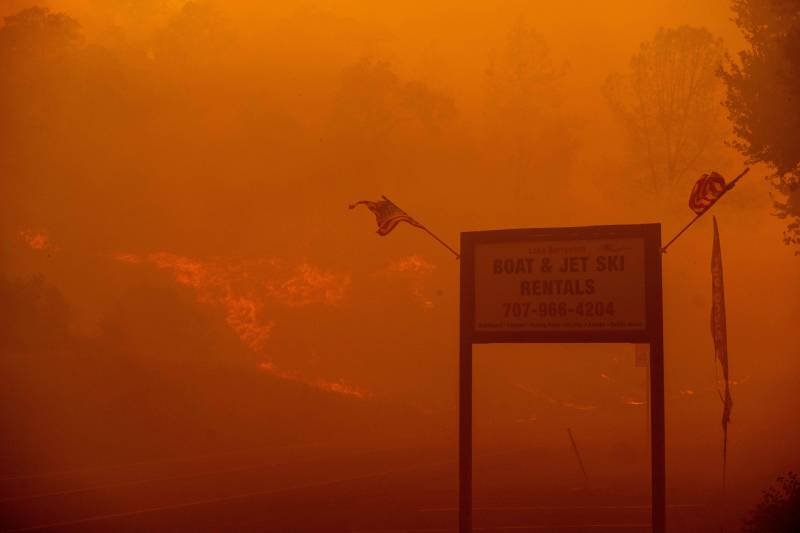The American Lung Association in California offered the following advice for local residents struggling with the simultaneous health risks of smoke, extreme heat and COVID-19:
- Stay inside as much as possible, with doors, windows and fireplace dampers shut — and clean air circulating through air conditioners and/or air cleaners. Residents should use the recirculation setting on their home air conditioners to avoid outdoor air contamination. Using whole house fans is not recommended because they can allow unfiltered outside air into the home.
- Those with chronic lung disease are encouraged to gather all their medications, delivery devices, prescriptions and insurance cards in one spot so they can quickly be transported in the event of an evacuation.
- If evacuating, remember to continue to follow guidance around COVID-19 such as practicing social distancing, wearing a cloth face covering and using hand sanitizer.
- Contact a physician immediately if lung disease symptoms worsen or are not relieved by the usual medicines. Seek medical attention if experiencing wheezing, shortness of breath, difficulty taking a full breath, chest heaviness, lightheadedness, and dizziness.
- Avoid exercising outdoors, particularly if you smell smoke or experience eye or throat irritation.
- For those returning to a fire-damaged home, limit exposure to ash by wearing protective clothing, gloves, goggles and a fitted N95 mask, if available. Note that a cloth mask, such as those often used to prevent the spread of COVID-19, will not adequately protect lungs from particles found in wildfire smoke.
Breathing particulate-heavy air could make people more susceptible to the novel coronavirus, says Dr. Madhavi Dandu, professor of medicine at UCSF.
“Air pollution and all type of particulate matter, but especially the particulate 2.5 that we see in fires, can really impact both lung health as well as just general immune health,” Dandu said. “One of the things that it does is destroy these little hairs that we call cilia that are in the lungs, which are ways to protect the lungs. They basically wipe off the germs, or spread off the germs, so that they don’t eventually get into the bloodstream.”
Dandu says given the health risks associated with breathing in smoke, “staying out of the polluted air if at all possible is the safest thing to do.”
‘A Very Complicated Situation’
Considering the array of disasters the region is now facing, Solano County Health Officer Dr. Bela Matyas says, the choices for staying safe are no longer cut and dried, and the confluence of heat and wildfire smoke amid the backdrop of the coronavirus pandemic is making an already difficult situation worse, particularly for people with underlying health conditions.
For instance, for the many people in the region without air conditioning, cooled public spaces like movie theaters, malls and libraries are closed due to the pandemic. So some people now face the hard trade-off between opening the windows to get relief from the heat and breathing in the smoke that it allows in.
“This is a very complicated situation. There is no perfect solution here, because solutions for one exacerbate the other,” Matyas said. “And so the compromise of trying to protect against all of these multiple things happening at the same time is the best that we can do.”
For people with a respiratory illness, breathing in wildfire smoke can be especially dangerous, he says. But those without underlying health concerns might consider opening the windows to cool their living space for a short time before closing them again.
For the most vulnerable, the county is operating three combined cooling-evacuation centers, Matyas says.
He called it “a little bit tricky, because as people are showing up, we need to screen them [for COVID-19]. But a lot of the symptoms that we screen for are actually created by the smoke. So a person shows up at an evacuation site coughing and short of breath, who’s just come from an evacuated zone within the fire. How do you know that it’s the smoke that did that as opposed to COVID?”
As for facial coverings, he distinguished between the less protective masks people are using to slow the spread of the coronavirus with the N95s that filter out harmful smoke particles.
“If you’re going to be going to a congregating environment like an evacuation center, by all means, bring your [anticoronavirus] mask so that when you’re indoors, you can maintain social distancing,” he said. “But I don’t think you can rely on masks as one of the elements of the strategy to protect against the smoke.
“N95 would be an appropriate type of mask to wear to protect yourself from dust and smoke. But those masks aren’t available” because of a shortage caused by the pandemic.
In San Francisco, which spent much of the day engulfed in air classified as “unhealthy,” either for sensitive groups or the general population, Mayor London Breed put the latest crises in the context of a warming globe.
“The effects of climate change are already being felt,” she said, “and sadly we know events like these are only going to become more common with drier weather and hotter temperatures.”

